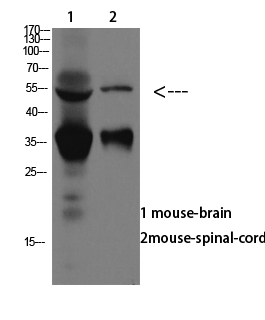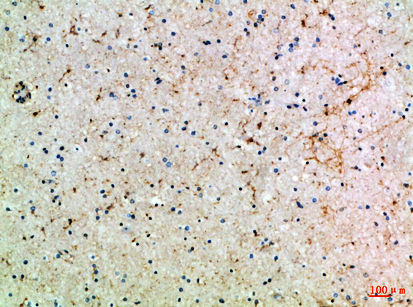ASIC1 Polyclonal Antibody
- Catalog No.:YT5875
- Applications:WB;IHC;IF;IHC-f;ELISA
- Reactivity:Human;Mouse;Rat
- Target:
- ASIC1
- Fields:
- >>Inflammatory mediator regulation of TRP channels
- Gene Name:
- ASIC1 ACCN2 BNAC2
- Protein Name:
- Acid-sensing ion channel 1 (ASIC1) (Amiloride-sensitive cation channel 2, neuronal) (Brain sodium channel 2) (BNaC2)
- Human Gene Id:
- 41
- Human Swiss Prot No:
- P78348
- Mouse Gene Id:
- 11419
- Mouse Swiss Prot No:
- Q6NXK8
- Rat Swiss Prot No:
- P55926
- Immunogen:
- Synthetic peptide from human protein at AA range: 220-280
- Specificity:
- The antibody detects endogenous ASIC1
- Formulation:
- Liquid in PBS containing 50% glycerol, 0.5% BSA and 0.02% sodium azide.
- Source:
- Polyclonal, Rabbit,IgG
- Dilution:
- WB 1:500-2000,IHC 1:500-200, ELISA 1:10000-20000. IF 1:50-200
- Purification:
- The antibody was affinity-purified from rabbit antiserum by affinity-chromatography using epitope-specific immunogen.
- Concentration:
- 1 mg/ml
- Storage Stability:
- -15°C to -25°C/1 year(Do not lower than -25°C)
- Other Name:
- Acid-sensing ion channel 1 (ASIC1;Amiloride-sensitive cation channel 2, neuronal;Brain sodium channel 2;BNaC2)
- Observed Band(KD):
- 70-75kD
- Background:
- This gene encodes a member of the acid-sensing ion channel (ASIC) family of proteins, which are part of the degenerin/epithelial sodium channel (DEG/ENaC) superfamily. Members of the ASIC family are sensitive to amiloride and function in neurotransmission. The encoded proteins function in learning, pain transduction, touch sensation, and development of memory and fear. Alternatively spliced transcript variants have been described. [provided by RefSeq, Feb 2012],
- Function:
- alternative products:The splice variant from ASIC1a described in mouse and rat, which gives rise to an isoform with different N-termini (Asic1b), does not seem to exist in human,function:Cation channel with high affinity for sodium, which is gated by extracellular protons and inhibited by the diuretic amiloride. Also permeable for Ca(2+), Li(+) and K(+). Generates a biphasic current with a fast inactivating and a slow sustained phase. Mediates glutamate-independent Ca(2+) entry into neurons upon acidosis. This Ca(2+) overloading is toxic for cortical neurons and may be in part responsible for ischemic brain injury. Heteromeric channel assembly seems to modulate channel properties. Functions as a postsynaptic proton receptor that influences intracellular Ca(2+) concentration and calmodulin-dependent protein kinase II phosphorylation and thereby the density of dendritic spines. Modulates a
- Subcellular Location:
- Cell membrane ; Multi-pass membrane protein . Localizes in synaptosomes at dendritic synapses of neurons. Colocalizes with DLG4 (By similarity). .
- Expression:
- Expressed in most or all neurons.
- June 19-2018
- WESTERN IMMUNOBLOTTING PROTOCOL
- June 19-2018
- IMMUNOHISTOCHEMISTRY-PARAFFIN PROTOCOL
- June 19-2018
- IMMUNOFLUORESCENCE PROTOCOL
- September 08-2020
- FLOW-CYTOMEYRT-PROTOCOL
- May 20-2022
- Cell-Based ELISA│解您多样本WB检测之困扰
- July 13-2018
- CELL-BASED-ELISA-PROTOCOL-FOR-ACETYL-PROTEIN
- July 13-2018
- CELL-BASED-ELISA-PROTOCOL-FOR-PHOSPHO-PROTEIN
- July 13-2018
- Antibody-FAQs
- Products Images

- Western blot analysis of mouse-brain, mouse-spinal-cord lysate, antibody was diluted at 1000. Secondary antibody(catalog#:RS0002) was diluted at 1:20000

- Immunohistochemical analysis of paraffin-embedded Human-brain, antibody was diluted at 1:100



